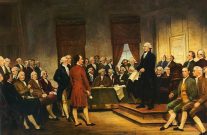We are told that judicial engagement will not lead to dueling natural rights jurists usurping republican government. But what rights do they see?
Protecting the Islands of Speech
Professor Epstein argues that all textual constitutional rights — most particularly, those pertaining to contracts, property, speech, and religion — should be protected by the same regime. This argument has intuitive appeal, but he does not defend it, at least not here. Why should we protect contracts and property as much as speech or religion? Because the Constitution speaks of them explicitly? It also speaks of “arms” and the right to a jury in “suits at common law” where twenty dollars and a penny is at stake. Should these rights as well enjoy robust protection?
One could argue, of course, that any right that appears in the Constitution is as important as any other, but this smacks of formalism. (Consider the many European constitutions that adopt aspects of the New Deal.) On a more substantive level, Professor Epstein could argue — as he does elsewhere — that the Constitution should strongly protect all rights that underlie a Lockean society. Property might come first, reflecting the moment when one “mixes his labour” with some part of nature’s bounty. Contract might come second, as it enables one to exchange what one has turned into property. Speech and religion might join this constellation on the ground that rights of confession were not surrendered in the social contract — an argument Locke himself made — or that such choices are a form of property. Professor McGinnis has made this point.
If Professor Epstein argues that the Constitution should protect property, contract, speech and religion, each in a robust way, for essentially Lockean reasons, he may be knocking on an open door. By this view, Kelo is subject to criticism for misreading “public use” as a broad conception of “public purpose.” If I may seize your land at a price set by a third party (a court), provided first I can persuade the government that I can use it better than you, then you no longer own it in the true Lockean sense. As Judge Calabresi and Douglas Melamed might put the matter, Kelo converts a regime of property into one of liability, with a public entity subject to capture in the middle.
Courts have not been kind to property and contract. Should they therefore abuse speech and religion? Does Professor Epstein suggest that we should hold the latter hostage, the better to protect the former? Or does he instead have in mind those instances where property or contract come into conflict with speech or religion? These are indeed difficult situations. As Professor Epstein observes, speech can sometimes constitute force or fraud. To the extent he is correct, he knocks on another open door.
But how far should we take this concept? Professor Epstein writes critically of Snyder v. Phelps (2011), a case about an “odious” protest (to use his apt word) near the funeral of a fallen marine. For sure, the signs were outrageous and quite likely to impose psychological damage on the father. One read “You Are Going to Hell,” another “Fag Troops.” The father brought an action for intentional infliction of emotional distress (among other things) and obtained judgment for $5 million after remittitur. Many would argue that the protesters got what was coming to them, and that the First Amendment should not stand in the way.
But is this so? The protest took place 1000 feet from the funeral, and the protesters were met by counter-protesters who demonstrated in support of the family. The father himself did not read the signs until he watched TV that night. Does this constitute “force” enough to justify Professor Epstein’s criticism? Is merely seeing the signs on TV enough? Professor Epstein does not address this point, but if so he appears to contemplate a global zone of psychological inviolability, at least where the speaker refers — even obliquely — to a specific private person. (Although none of the signs included the marine’s name, some did include the word “you.”) Consider how much political dialogue such a regime would exclude. Caustic speech might be protected, but not caustic speech that brought a private person within its reach. One could complain about entitlements, but one could not refer to its beneficiaries. One could complain about a strike, but one could not refer to the strikers. One could complain about a curriculum, but one could not refer to the professors or students who implemented it.
Alternately, Professor Epstein could argue that the combination of seeing the signs on TV and knowing they were held 1000 feet from the funeral constituted the requisite invasion of Mr. Snyder’s personal space, and thus a form of force. There is something of the Ptolemaic about this formulation, however, suggesting a regime that would provide no haven for speech. At the end of the day, then, Professor Epstein might be better off to concede that 1000 feet is far enough away for the First Amendment to attach, and to make his defense at a closer radius. In holding against Mr. Snyder, the Court was careful not to repudiate the doctrine of “fighting words,” by which the Constitution does not protect “personally abusive epithets . . . addressed to the ordinary citizen.” Cohen v. California (1971). Paradigmatically, “addressed” has always contemplated something of the physical. The protesters, however, were at a great distance from Mr. Snyder, who could not see their signs.
With respect, I must also disagree with Professor Epstein’s argument that the First Amendment should apply most fully to prior restraints, and less so to judgments after the fact. A judgment of $5 million, if imposed, would restrain almost any speaker from repeating the message in question. Moreover, the common law is only as efficient as the factors that inform its judgment. A close community might adopt efficient intramural norms, yet adopt inefficient norms with respect to outsiders, externalizing costs upon them. Juries and judges might well seek to exclude caustic, unorthodox speech on the very grounds that it is caustic and unorthodox. Professor Epstein’s vision of the First Amendment would extend Robert Nozick’s “utopia of utopias” to the public sphere.
Professor Epstein also takes the Court to task for its decision in Brown v. Entertainment Merchants Association (2011). Here, his criticism does not appear to rely on Locke, at least not in the classic sense. For example, he does not appear to defend the statute as a necessary regulation of private behavior for the sake of order. Instead he defends it as an appropriate regulation of morals, referring to the government’s power to regulate obscenity.
One weakness in his argument is best captured in the metaphor of water under the bridge. The path of the First Amendment going forward is largely dictated by the path it has taken. For close to a century, the Court has spoken in terms of protected and unprotected speech, gradually including more and more speech within the scope of protection, and occasionally acknowledging that a particular form of speech, such as child pornography, is not on the island. Speech on the island enjoys maximum protection — strict scrutiny, with all the bells and whistles. If not, the plunge is rapid. The government might well win; circumstances matter; protracted litigation or negotiation is the norm; even criminal liability may ensue. Consider, for example, the difference between speech promoting a specific policy and speech promoting a specific product. Strict scrutiny protects the former, intermediate scrutiny the latter. Meanwhile, obscenity, fighting words, incitement, many forms of defamation and certain other categories are outlaws, largely if not completely excluded from protection. The lines between the categories may not be drawn with perfection, especially those dividing obscene from non-obscene speech, but they do have enough clarity that speakers by and large can operate with a high degree of confidence that the Constitution will protect them.
For video games, falling within the inner circle of protection — in other words, not falling off the cliff — was indeed critical. Thus, Professor Epstein is not far off in saying that “to read Justice Scalia’s opinion, one would think the entire edifice of freedom of speech would collapse of its own weight if this statute were allowed to remain on the books.” His error, with respect, lies not in his saying this, but in his refusal to believe it is true. Losing the protection of strict scrutiny most likely would have left video games vulnerable to regulatory apparatuses along the lines of the FTC, FDA or SEC. Such was the experience of motion pictures during the regime of Mutual Film Corp. v. Industrial Commission of Ohio (1915), where the Court saw no conflict between free speech and a statute that required distributors to submit films to a “board of censors” before they could be shown in the state. (Ohio was afraid of socialist propaganda.) Such a loss would also expose video games to potentially crippling civil actions, where plaintiffs might seek to attribute an act of actual violence, such as a school shooting, to the shooter’s having played a video game. In Brown, video games were energetically — and appropriately — resisting being categorized halfway between tobacco and the movies, books and epic poems from which they derive their narrative structure.
As an artistic medium, video games are an extension from film, just as film was an extension from plays, novels, and epic poems. As a formal matter, they bear many of the same characteristics as their predecessors. They have characters, dialogue, sets, props, music, and a plot in which the parameters are set by the authors but realization is effected by the player in relation to those parameters. The First Amendment protects the Iliad, with all of its gruesome violence. So too would it protect a film of the Iliad. And so too would it protect a video game derived from the epic. Although Professor Epstein decries some games for their poor quality — and he may be right — the First Amendment protects bad movies along with good ones. In any case, the very games that serve up substantial possibilities of violence, such as “Grand Theft Auto,” ironically also serve up substantial possibilities of narrative development. Professor Henry Jenkins at MIT has made this point.
Schools of art now have programs devoted to video games. The gross receipts of this industry now rival and may even exceed those of the film industry. Films have adopted the characters and tropes of video games, reversing the current of influence. Indeed, a stage production has run in New York, “Game Play,” that subjects the plots of video games to postmodernist comedy. Animals that can breed with each other share enough DNA to deserve the same level of protection.
Professor Epstein may be correct to describe the Court’s recent jurisprudence under the First Amendment as “rigid.” Although “rigidity” per se is hard to defend, Professor Epstein nevertheless may be mistaking a virtue for a flaw. Justice Scalia is reacting to the possibility that legislatures will try to break off small areas of speech from the protected island and reallocate them to the atolls of vulnerability. If legislatures may do this, the First Amendment will lose much of its predictability, and vibrant areas of human endeavor might suffer. In taking this approach, Justice Scalia is roughly replicating his approach to regulatory takings, where he would limit the legislature’s ability to define property out of existence by statutory means. (See Lucas v. South Carolina Coastal Council.)


